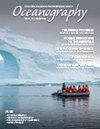New Technologies Aid Understanding of the Factors Affecting Adélie Penguin Foraging
IF 2.8
4区 地球科学
Q1 OCEANOGRAPHY
引用次数: 0
Abstract
Adélie penguins (Pygoscelis adeliae), as well as substantial numbers of Emperor penguins (Aptenodytes forsteri), Weddell seals (Leptonychotes weddellii), and pelagic birds (Smith et al., 2014). Among these, the Commission for the Conservation of Antarctic Marine Resources (CCAMLR) has designated the Adélie penguin an “indicator species” for monitoring ecosystem structure and function in the newly designated Ross Sea Region Marine Protected Area (RSR-MPA). This penguin, among the best-known seabirds, has been studied for decades at multiple locations with investigations that have delved into its population history (both recent and through thousands of years), survival strategies, responses to environmental changes, and feeding ecology (summarized in Ainley, 2002, with numerous papers published thereafter). Penguin populations are increasing in the southern Ross Sea, potentially indicating a broad response to an environment being altered by climate change and increased fishing activity. Despite extensive research, our understanding of the species’ response to its changing habitat and food web is incomplete. Sea ice in the Ross Sea region has been increasing, at least until recent years, and this would be expected to affect populations of species that depend on the ice for predator avoidance and availability of New Technologies Aid Understanding of the Factors Affecting Adélie Penguin Foraging新技术有助于了解影响企鹅觅食的因素
还有大量的帝王企鹅(Aptenodytes forsteri)、威德尔海豹(Leptonychotes weddellii)和远洋鸟类(Smith et al., 2014)。其中,南极海洋资源保护委员会(CCAMLR)已将adsamlie企鹅指定为监测新指定的罗斯海区域海洋保护区(RSR-MPA)生态系统结构和功能的“指示物种”。这种企鹅是最著名的海鸟之一,几十年来,人们在多个地点研究了它的种群历史(最近和几千年)、生存策略、对环境变化的反应和摄食生态(2002年Ainley总结了这一点,此后发表了许多论文)。罗斯海南部的企鹅数量正在增加,这可能表明气候变化和捕鱼活动增加对环境的改变做出了广泛的反应。尽管进行了广泛的研究,但我们对该物种对其不断变化的栖息地和食物网的反应的了解尚不完整。罗斯海地区的海冰一直在增加,至少直到最近几年,这可能会影响依赖于冰面躲避捕食者的物种的数量,以及新技术的可用性,这有助于了解影响企鹅觅食的因素
本文章由计算机程序翻译,如有差异,请以英文原文为准。
求助全文
约1分钟内获得全文
求助全文
来源期刊

Oceanography
地学-海洋学
CiteScore
6.10
自引率
3.60%
发文量
39
审稿时长
6-12 weeks
期刊介绍:
First published in July 1988, Oceanography is the official magazine of The Oceanography Society. It contains peer-reviewed articles that chronicle all aspects of ocean science and its applications. In addition, Oceanography solicits and publishes news and information, meeting reports, hands-on laboratory exercises, career profiles, book reviews, and shorter, editor-reviewed articles that address public policy and education and how they are affected by science and technology. We encourage submission of short papers to the Breaking Waves section that describe novel approaches to multidisciplinary problems in ocean science.
 求助内容:
求助内容: 应助结果提醒方式:
应助结果提醒方式:


